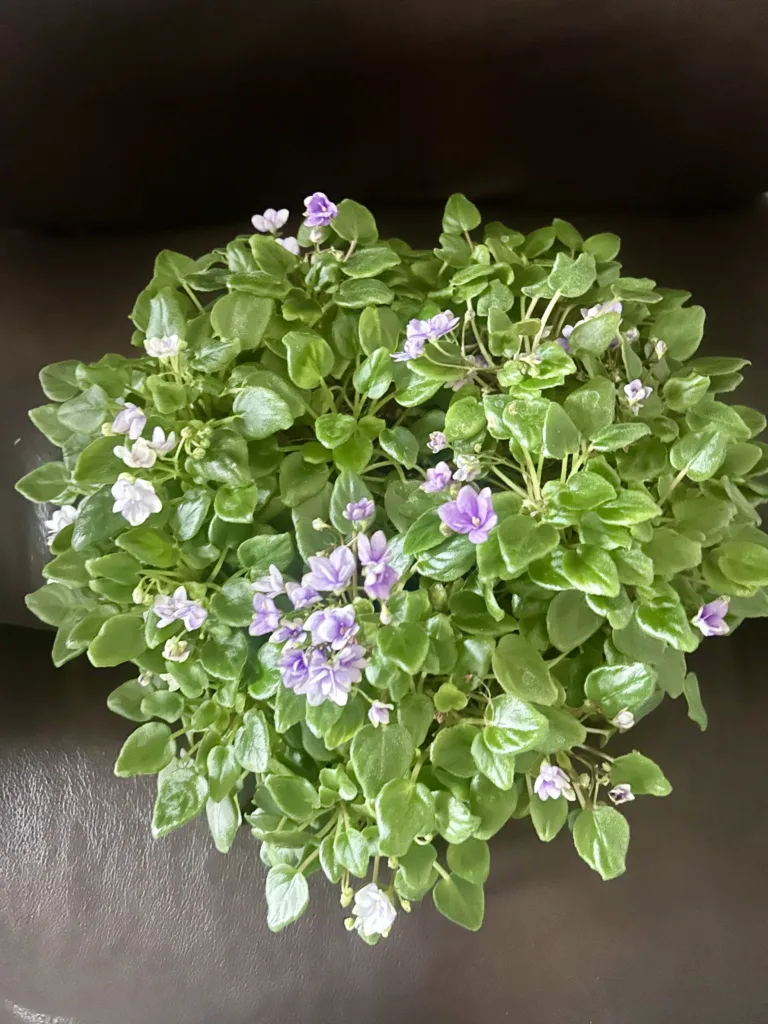
African violets, scientifically known as Saintpaulia, are a genus of flowering plants in the family Gesneriaceae. Native to eastern tropical Africa, these plants are admired for their velvety, round or oval leaves and clusters of violet, white, or pink flowers. These perennial, evergreen houseplants are compact and typically 2-6 inches tall, making them perfect for small spaces. They bloom several times a year with proper care, adding beauty and vibrancy to your indoor environment. In this blog post we will discuss how to grow an African Violet in a Terra Cotta pot. In the picture is a trailing AV planted in a hens and chickens terra cotta pot that measures 6″ wide and 4″ tall. I did this as an experiment to see if I could grow an AV in Terra Cotta. As you can see this AV clearly loves this pot and now 14″ across!
Choosing the Right Terra Cotta Pot Size
When choosing a terra cotta pot for your African violets, size is a critical factor to consider. These plants prefer a snug fit, and as a general rule, the diameter of the pot should be one-third the size of the plant’s spread. For instance, if your African violet measures 9 inches across, select a pot with a diameter of approximately 3 inches. A pot too large can lead to overwatering and root rot, while a pot too small might not provide enough room for the roots to grow. Terra cotta pots are especially beneficial as they allow soil to breathe, helping to prevent water-logged roots.
Soil Type for African Violets
The choice of soil is of utmost importance for the successful cultivation of African violets. It’s crucial to use a light, well-draining soil mix that retains enough moisture without becoming waterlogged. A good choice is an African violet potting mix, which is specifically designed to cater to their nutrient needs. This mix typically contains peat moss, perlite, and vermiculite, providing a perfect balance of aeration, moisture retention, and nutrients. If an African violet mix is not available, you can make your own using 2 parts peat moss, 1 part vermiculite and 1 part perlite. Remember, the key is to provide a soil environment that is moist, but never soggy.
Lighting for African Violets
Lighting is a crucial element in the care of African violets. These plants thrive under bright but indirect sunlight. A north or east-facing window is typically ideal for this purpose. Too much direct sunlight can cause the leaves to turn yellow or get scorched, while insufficient light may result in poor growth and fewer blooms. If natural light is inadequate, grow lights can be a great alternative. They provide the full spectrum of light that the plant needs and should be placed 12-15 inches above the plant for about 12-14 hours a day. Remember, adjusting the light conditions to mimic the plant’s natural habitat can significantly enhance its growth and blooming.
Watering and Fertilizing African Violets
Regular fertilization is key to keeping African violets healthy and promoting robust bloom cycles. A balanced, water-soluble fertilizer designed for blooming houseplants can be used. I like to fertilize on a weekly basis, alternating between full and half strength. This means one week, you would apply the fertilizer at the recommended dosage, and the following week, you would use half that amount. This alternating schedule helps prevent fertilizer burn, while still providing the nutrients your African violets need to thrive and continuously bloom. I use Shultz’s AV fertilizer and mix it in a gallon of water, watering my African Violets weekly.
Happy Gardening!
Growing African violets in a terra cotta pot is a fun and rewarding hobby. Remember to choose the right pot, use well-draining soil, provide bright but indirect light, water carefully, and fertilize regularly. With a little bit of love and attention, your African violets will thrive and reward you with colorful blooms year-round.
Please be sure to check out my Gardening Blog Post Page for more tips on all types of gardening. Including Seed Saving, Seed Starting, Orchids, Water Gardening, Coldframe Gardening, Indoor Bulb Gardening, Hydroponics, Container Gardening, Mums, Herbs, African Violets, planting Bulbs, Flower Gardening, Vegetable and Fruit Gardening, Indoor Houseplants of all kinds, Cactus, Succulents, Hanging plants, Deer resistant plants and even Bird, Bee, Butterfly and Hummingbird Gardens!
